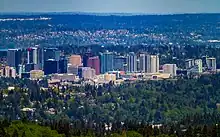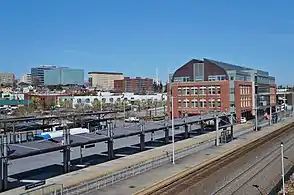Seattle metropolitan area
The Seattle metropolitan area is an urban conglomeration in the U.S. state of Washington that comprises Seattle, its surrounding satellites and suburbs. It contains the three most populous counties in the state, King, Pierce, and Snohomish counties, and is considered part of the greater Puget Sound region. The United States Census Bureau defines the metropolitan area as the Seattle–Tacoma–Bellevue, WA metropolitan statistical area. With an estimated population of 4,102,400 as of 2022,[1] it is the 15th-largest metropolitan statistical area (MSA) in the United States and home to over half of Washington's population.
Seattle metropolitan area | |
|---|---|
| Seattle-Tacoma-Bellevue, WA MSA | |
 Downtown Seattle as seen from Kerry Park in October 2019 | |
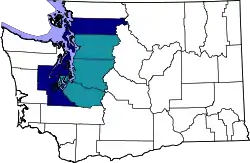 A map of the Seattle MSA, highlighted in teal (the Combined Statistical Area is in navy blue) | |
| Coordinates: 47°44′N 122°19′W | |
| Country | |
| State | |
| Largest city | Seattle (762,500) |
| Other cities | - Tacoma (220,800) - Bellevue (153,900) - Kent (137,900) - Everett (113,300) - Renton (107,500) |
| Area | |
| • Total | 5,872.35 sq mi (15,209.3 km2) |
| Highest elevation | 14,411 ft (4,392 m) |
| Lowest elevation | 0 ft (0 m) |
| Population | |
| • Total | 4,102,400 |
| • Rank | 15th in the U.S. |
| • Density | 700/sq mi (270/km2) |
Definition
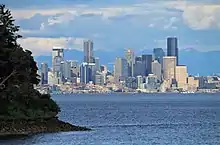
As defined by the U.S. Census Bureau, the Seattle metropolitan area includes:
- Seattle–Bellevue–Everett metropolitan division
- King County: Seattle and its immediate vicinity
- Snohomish County: north of Seattle
- Tacoma metropolitan division
- Pierce County: south of Seattle
Based on commuting patterns, the adjacent metropolitan areas of Olympia, Bremerton, and Mount Vernon, along with a few smaller satellite urban areas, are grouped together in a wider labor market region known as the Seattle–Tacoma Combined Statistical Area (CSA) (See Figure STO), commonly known as the Puget Sound region. The population of this wider region is 4,686,536—roughly two-thirds of Washington's population—as of 2017.[1] The Seattle CSA is the 14th largest CSA, and the 13th largest primary census statistical area in the country. The additional metropolitan and micropolitan areas included are:
- Bremerton–Silverdale metropolitan area
- Kitsap County: west of Seattle, separated from the city by Puget Sound; connected to Seattle by ferry and to Tacoma by the Tacoma Narrows Bridge
- Olympia metropolitan area
- Thurston County: southwest of Seattle, at the south end of Puget Sound
- Mount Vernon–Anacortes metropolitan area
- Oak Harbor micropolitan area
- Island County: northwest of Everett, encompassing Whidbey and Camano Islands in Puget Sound
- Shelton micropolitan area
- Mason County: west of Tacoma and northwest of Olympia
Demographics
| Census | Pop. | Note | %± |
|---|---|---|---|
| 1870 | 4,128 | — | |
| 1880 | 11,616 | 181.4% | |
| 1890 | 123,443 | 962.7% | |
| 1900 | 189,518 | 53.5% | |
| 1910 | 464,659 | 145.2% | |
| 1920 | 601,090 | 29.4% | |
| 1930 | 706,220 | 17.5% | |
| 1940 | 775,815 | 9.9% | |
| 1950 | 1,120,448 | 44.4% | |
| 1960 | 1,428,803 | 27.5% | |
| 1970 | 1,832,896 | 28.3% | |
| 1980 | 2,093,112 | 14.2% | |
| 1990 | 2,559,164 | 22.3% | |
| 2000 | 3,043,878 | 18.9% | |
| 2010 | 3,439,809 | 13.0% | |
| 2020 | 4,018,762 | 16.8% | |
| 2022 (est.) | 4,034,248 | 0.4% | |
| U.S. Decennial Census 2019 estimate | |||
As of the 2020 census there were 4,018,762 people in the area.[2] In 2019 the estimated median income for a household in the Seattle metropolitan area was $94,027. The per capita income was $49,184.[3]
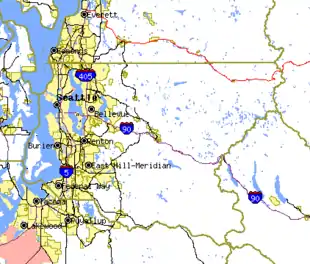
| County | 2020 Census | 2010 Census | Change | Area | Density |
|---|---|---|---|---|---|
| King County | 2,269,675 | 1,931,249 | +17.52% | 2,115.56 sq mi (5,479.3 km2) | 1,035/sq mi (399/km2) |
| Pierce County | 921,130 | 795,225 | +15.83% | 1,669.51 sq mi (4,324.0 km2) | 552/sq mi (213/km2) |
| Snohomish County | 827,957 | 713,335 | +16.07% | 2,087.27 sq mi (5,406.0 km2) | 397/sq mi (153/km2) |
| Total | 4,018,762 | 3,439,809 | +16.83% | 5,872.34 sq mi (15,209.3 km2) | 659/sq mi (254/km2) |
Religion
According to the Pew Research Center's 2014 U.S. Religious Landscape Study, the Seattle metropolitan area's religious affiliation is as follows:[4]
| Religious composition | 2014 |
|---|---|
| Christian | 52% |
| —Evangelical Protestant | 23% |
| —Mainline Protestant | 10% |
| —Black Protestant | 1% |
| Catholic | 15% |
| Non-Christian Faiths | 10% |
| —Jewish | 1% |
| —Muslim | < 1% |
| —Buddhist | 2% |
| —Hindu | 2% |
| Unaffiliated | 37% |
| Don't know | 1% |
Cities

- Major
- Other
- Arlington
- Auburn
- Bainbridge Island
- Beaux Arts Village
- Bonney Lake
- Bothell
- Bremerton
- Brier
- Buckley
- Burien
- Covington
- Des Moines
- Duvall
- Enumclaw
- Edmonds
- Federal Way
- Gig Harbor
- Gold Bar
- Granite Falls
- Issaquah
- Kenmore
- Kirkland
- Lake Forest Park
- Lake Stevens
- Lakewood
- Lynnwood
- Maple Valley
- Marysville
- Mercer Island
- Mill Creek
- Monroe
- Mountlake Terrace
- Mount Vernon
- Mukilteo
- Newcastle
- Normandy Park
- North Bend
- Olympia
- Orting
- Puyallup
- Poulsbo
- Redmond
- Renton
- Sammamish
- SeaTac
- Shoreline
- Silverdale
- Snohomish
- Snoqualmie
- Stanwood
- Sultan
- Sumner
- Tukwila
- Woodinville
- Woodway
Commerce
The Seattle metropolitan area is home to numerous large scale businesses.[5] Retail giants such as Microsoft, Amazon, REI, Nordstrom, Starbucks, and Costco were founded and continue to be headquartered in the greater Seattle area.[5]
Over the past decade, tech companies began expanding their roots into the Seattle metropolitan area and opening offices on both sides of Lake Washington (Seattle and Bellevue, primarily). These companies, traditionally known for their history in Silicon Valley and the bay area, include Facebook, Salesforce, Google, and Zynga.[6]
Transportation
Major airports
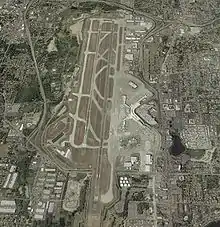
The largest airport in the region is Seattle–Tacoma International Airport in SeaTac, an International airport that serves as a commercial hub for Alaska Airlines and Delta Air Lines.
The other airports in the area are:
- Paine Field (passenger and general)[7]
- Boeing Field (passenger and cargo)
- Harvey Airfield (general)
- Renton Municipal Airport (general)
Major highways
Mass transit
- Sound Transit, trains, buses, light rail in Puget Sound area
- Community Transit, buses in Snohomish County except Everett
- King County Metro, buses in King County
- Pierce Transit, buses in Pierce County
- Everett Transit, bus service in the city of Everett
- Kitsap Transit, buses and ferry service in Kitsap County
- Intercity Transit, bus service in Thurston County
- Mason Transit Authority, bus service in Mason County
- Seattle Streetcar, streetcar service in the city of Seattle
- Seattle Center Monorail
References
- "ACS DEMOGRAPHIC AND HOUSING ESTIMATES". United States Census Bureau.
- "2020 Population and Housing State Data". United States Census Bureau, Population Division. August 12, 2021. Retrieved August 14, 2021.
- "Census profile: Seattle-Tacoma-Bellevue, WA Metro Area". Census Reporter. Retrieved April 17, 2021.
- "Religious Landscape Study". Pew Research Center's Religion & Public Life Project. Retrieved November 10, 2015.
- "About Seattle". Seattle Chamber of Commerce.
- Wingfield, Nick (June 2, 2011). "Bay Area Technology Firms Put Down Roots in Seattle". Wall Street Journal. ISSN 0099-9660. Retrieved May 4, 2021.
- Blethen, Ryan (March 4, 2019). "How the first day of commercial flights from Paine Field went". The Seattle Times. Retrieved March 8, 2019.

.jpg.webp)
